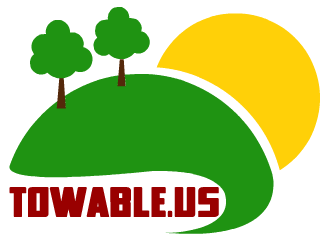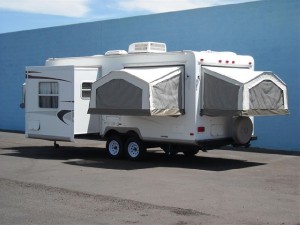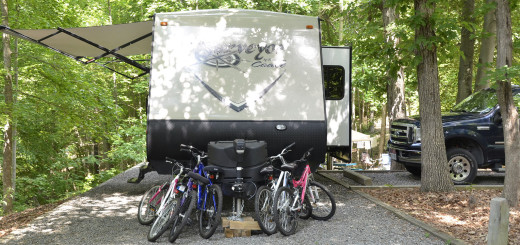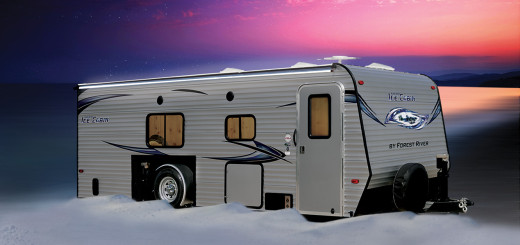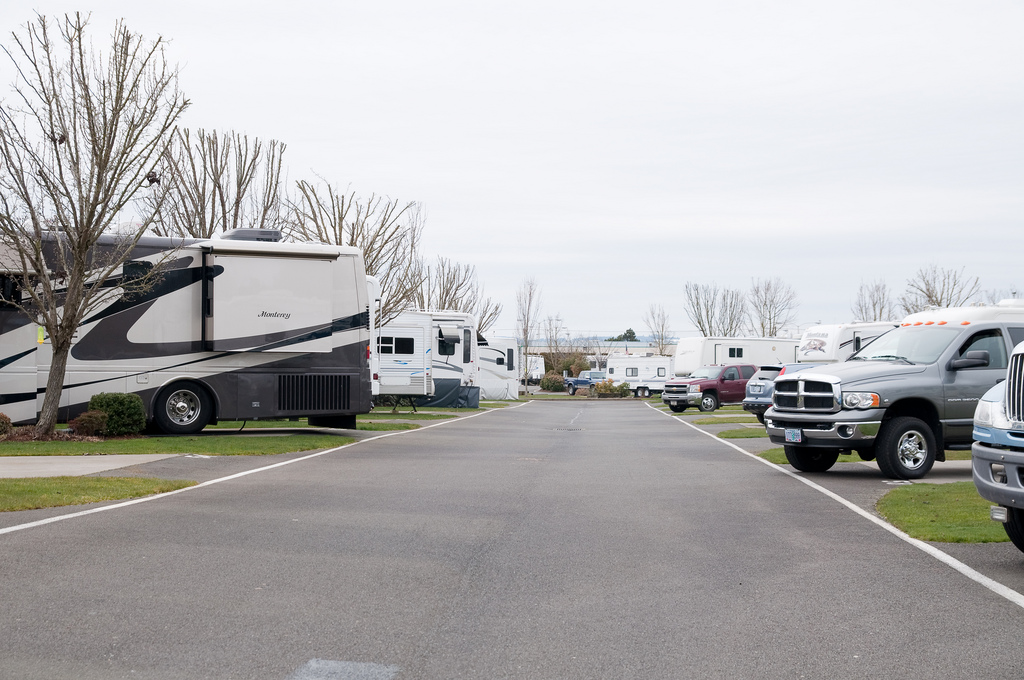Camping means many things to many people, and the concept of roughing it doesn’t always figure in. Sure the most basic definition of camping involves pitching a tent in the wilderness, but come on. If you’re going to go all gung ho anyway, what kind of baby needs a tent? Pack in, pack out, sleep under some leaves, and do your business in a hole you dug behind a log like a real man. Who needs toilet paper when there’s so much poison ivy just laying around everywhere? Anyway, tents don’t hold heat very well in the first place, when you think about it, and the walls tend to sweat when wet, and where are you supposed to plug in your coffee maker, and curling iron, and George Foreman grill, anyway?
Think about it. Just for a minute, think about it. Do you really have to sleep with your head on a rock to enjoy the outdoors? Is that really such a big part of the experience? No, you don’t, and no it isn’t, and that’s why they invented towable RVs. And when you have too many kids, or pets, or it won’t stop raining and you can’t stop bumping into someone every time you turn around? That’s why they invented expandable RVs.
The Invaluable Expandable Traveling Trailer
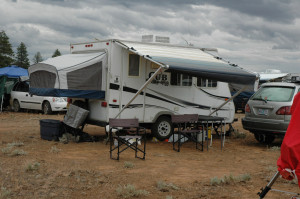
More than meets the eye, travel trailers in disguise. Image courtesy Dennis Recla, via Flickr (Creative Commons 2.0)
Some types of towable RVs are just boxes on wheels. They have solid roofs, and walls, so they’ll keep the rain off your head and the wind off your back, but that’s about it. What you see is what you get, and what you get is kind of boring. And probably cramped. And if you have kids, and they want to bring any friends along on your camping trip, someone is invariably going to end up sleeping on the floor, or out in the tent, and then that jerk is going to end up with more camping street cred than you because they were roughing it.
So how do you get more living space, and more sleeping space, and more everything space, without buying a new truck that’s capable of towing the space shuttle? There are actually three different kinds of expandable towable RVs, and each one has its own set of benefits and drawbacks to weigh.
The three types of expandable RVs are:
- Pop ups are tiny little travel trailers that collapse down to about four or five feet in height. When popped up, the walls of a pop up camping trailer are made of tent material, and they usually have fold out bunks to provide more sleeping space.
- Hybrids are larger towables that have solid walls and ceilings, so they are indistinguishable from regular travel trailers most of the time. However, they conceal a dirty little secret: they are pop up camping trailers all grown up. One end, or both ends, or both ends and one side, are capable of folding out into the same type of bunks that you see on pop up trailers.
- Slide outs are found in both towable and motorized RVs. This feature involves one or more sides of the rig literally sliding out. The slide typically houses a dinette, sofa, bed, or even kitchen. When slid in, the quarters are usually pretty cramped, but when slid out, you gain a tremendous amount of floor space.
While these are the three basic ways that a towable RV can expand, they aren’t monolithic categories. Pop ups can slide out, and larger travel trailers can have both hybrid pop out bunks and hard-walled slide outs. It’s all terribly complex, but the upshot is that whatever combination of the three appeals to you, you’ll almost certainly be able to find at least one manufacturer that caters to your deepest desires.
The Tiniest Expandable RVs
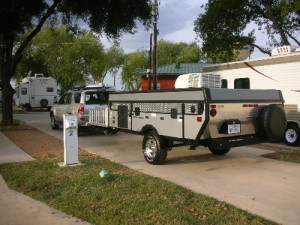
Pop ups are often towable by station wagons, crossovers, and other lightweight vehicles. Image courtesy d lo, via Flickr (Creative Commons 2.0)
The smallest, lightest, closest-to-real-man-mode-camping expandable RVs are pop up camping trailers. They come in two basic flavors: tent trailers and a-frame campers, and aside from tiny teardrops, they’re the only class of towable RV that you can safely haul behind a passenger car or minivan. Not all pop ups are that light, and some are downright heavy, but tent trailers in the 8′ – 10′ range are typically just what you’re looking for if what you’re looking for is a towable RV you can hook up to a class I hitch without taking your life into your own hands, but you still aren’t that married to the idea of sleeping on a rock.
A-frame pop ups are a little different. They’re often called “hard walled” or “hard sided” camping trailers because they are roughly the same size, when collapsed, as tent trailers, but they don’t have walls made of tent material. The walls, when expanded, consist of two triangular walls and two rectangular roof panels, which is where this type of expandable gets its name: they look like tiny a-frame houses on wheels.
Tent trailers offer better protection from the elements than normal tents, they lift you up off the ground, and they offer a pretty decent amount of sleeping and living space for the tiny footprints they have when folded for travel or storage. However, the tent walls and bunks don’t hold heat very well in cold weather. A-frames are better at that, since they have solid walls, but they also have less sleeping space, since they don’t have fold out bunks.
Larger pop up camping trailers and a-frames sometimes include hard-walled slide outs just like bigger rigs. Due to the increased amount of floorspace when the slide out is slid out, it’s even possible to find a-frame campers with slide outs and hard-walled, fully-enclosed bathrooms. Talk about luxury. What was that about pooping in a hole behind a log? Nevermind!
Hybrid Travel Trailers
Hybrids are like travel trailers plus. Plus what? Plus so much more. Okay, actually just plus one or more fold-out bunks. From the outside, these rigs look like normal travel trailers, and they are in most respects. They have hard, insulated walls, so they’re suited perfectly well to cold weather camping, and they’re available in all different sizes, from sub-20′ to pushing 30′. But if you need some additional sleeping space, they include at least one fold out bunk, which, when folded out, looks a lot like the bunks you see on pop up campers. That means that while the bunk platform itself is solid, the walls and roof are made of tent material. So they don’t add a whole lot of weight, which is a plus if your tow vehicle is on the lighter side, but they also don’t do that great a job holding heat.
Most hybrids have a single bunk on the front or the rear, or bunks on both the front and the rear, but some have fold-outs on one side or the other in addition to, or instead of, the traditional front and rear bunks. Additionally, some hybrids include a mixture of soft-walled pop outs and hard-sided slide outs. So if you want to option to leave your bunks folded up in cold weather, but you still want extra floor space from a hard-walled slide, you’ll probably be able to find something that tickles your fancy.
Slide Out Towables
Slides originally showed up in high end class A motorhomes, soon made their way to large fifth wheels, and eventually trickled down to travel trailers and even pop up camping trailers. The basic idea behind a slide is that a portion of the wall of an RV is cut out, and a box with one open wall is slid in to seal the hole. With the push of a button, the box slides out, re-seals the hole, and clears up several square feet of floor space. A “single slide” will typically hold either a dinette or couch, while a “double slide” may hold both a dinette and a couch, most or all of the kitchen, or some combination thereof.
The main benefit of a slide, in comparison to other types of expandable RVs, is that the walls and roof are all solid. That means slides can be used in all kinds of weather without letting the elements in. However, it also means that towable RVs with slides are heavier than similarly sized towables without slides or even similarly sized hybrids. The soft walled pop outs found in hybrids don’t weigh nearly what a hard walled slide out does, and the slide out also comes with additional weight in the form of the mechanism used to slide it in and out.
Finding the Right Expandable RV
Since each type of expandable has its own benefits and drawbacks, and a number of manufacturers offer a huge selection of combinations, the process of finding the right one really just comes down to a cost/benefit analysis. If you have a vehicle that isn’t capable of towing much weight, then you’ll want to look at pop up camping trailers, and if you have a little more wiggle room, then you can check out rigs that include a slide, and maybe even a hard-walled bathroom. If you want to camp in the winter, then you’ll want to check out an a-frame, a hybrid, or even a larger travel trailer with slides. And if you want the ultimate in flexibility, and you can tow a decent amount of weight, then a hybrid with one or more slides might be just what you’re looking for. Unless you’re looking to rough it, in which case I’ve got a pile of rocks and a hole behind a log with your name on them.
